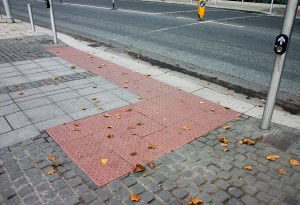For designers who are actually interested in conforming to agreed standards of excellence on accessible information and universal design, it can often be difficult to find the relevant information and guidelines.
Below are some samples of where to begin finding information on how to design your product, building, website or printed information, for all:
Web Accessibility
The World Wide Web Consortium (W3C) is currently the main provider of international standards for the Internet. W3C have developed a number of widely-used Web Content Accessibility Guidelines with the intention of making online content more accessible to people with disabilities, but also to all other users.
The aim of the W3C is to cater for a variety of users, interfaces (pc/laptop, voice browser, mobile phone, PDA etc) and circumstances which might normally make finding and accessing information online more difficult. For example, websites that conform to W3C standards will be more accessible to a visually impaired user using a voice browser, as well as a commuter reading emails on their mobile phone on a busy, badly-lit subway train.
More information on how these guidelines were developed, as well as implementation advice, is available on the W3C website.
Printed Information
The Royal National Institute for the Blind (RNIB) have developed a series of guidelines for printed materials, entitled “See it Right”. This information is available in a printed guide and includes sections on:
- Information on the law regarding accessible information.
- Statistics and other information on the prevalence of sight loss.
- Explanations of large print, audio, tactile and electronic information and how to produce these alternative formats.
- Creating accessible signage
- Making meetings and presentations more accessible to people with sight problems.
This information is also available in the Clear Print section of the RNIB website. To get you started, a brief list of helpful pointers from the Clear Print section of the RNIB website, most of which pertain to online content as well as printed items:
- Document text size should be 12-14 pt, preferably 14 pt.
- The font you choose should be clear, avoiding anything stylised
- Keep the text layout clear, simple and consistent
- Don’t use blocks of capitalised letters, and try not to use any italics or underlining, use bold sparingly
- Text shouldn’t be overlaid on images
- The contrast between the text and background should be as high as possible
- Any information conveyed in colour or through images is also described
Built Environment
 In Ireland, the most well-known guide to accessible building design is the “Building for Everyone” guide, officially launched by the National Disability Authority in 2002.
In Ireland, the most well-known guide to accessible building design is the “Building for Everyone” guide, officially launched by the National Disability Authority in 2002.
This document contains diagrams and detailed information on the design of accessible interior and exterior environments and services, as well as information on retro-fitting and maintenance.
As the NDA’s website describes:
With over 200 pages of diagrams, checklists, detailed specifications and colour photographs, Building for Everyone demonstrates how you can:
- Design an accessible bathroom
- Install a ramp into your office or home
- Widen doors
- Design accessible elevators
- Create an accessible external (outdoors) environment
For more information, please visit the National Disability Authority’s website.
Product Design
Given the broad nature of the term “Product Design”, and the multitudinous issues which each individual product inevitably bring up, there are a number of different resources available for procuring information and advice on how to design inclusively.
A Centre of Excellence in universal or accessible design should provide some information. Prominent examples include:
- Ireland’s Centre of Exellence in Universal Design.
- USA’s Centre for Universal Design, North Carolina State University.
Other organisations have been dedicated solely to the issue of accessibility. The Inclusive Design Toolkit, mentioned in a previous post, is a very useful resource in helping designers to consider other levels of ability and modes of perception.
Ergonomics guides are also imperative in the design process, in order to ensure the usability of your product for as many users as possible. One book that I have personally found to be a useful starting point is the Stephen Pheasant guide: Body Space: Anthropometry, Ergonomics and the Design of Work (2nd Ed.).
Unfortunately, designing accessible products and services is such a widely-reaching brief that it is impossible to provide a one-stop-shop for all information on designing inclusively. Some advice would be to include as much ethnographic user testing as possible, throughout all stages of the design and with a broad range of users.
This really seems to be the best way to test your preconceptions about the users of your design and to evolve your ideas in order to reach those users you are trying to benefit.
Any suggestions or useful resources that you have come across which might be useful to include here are welcome.
